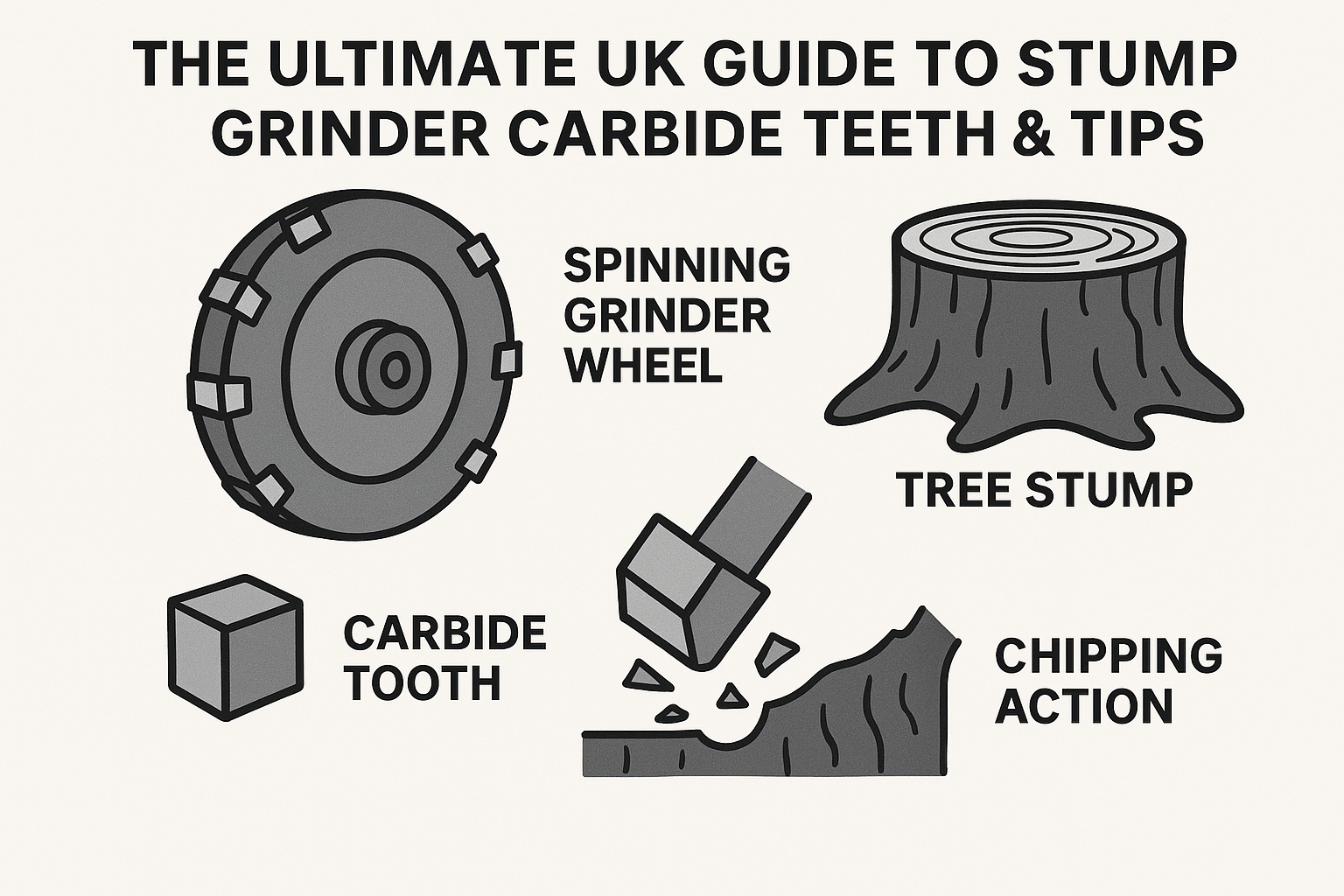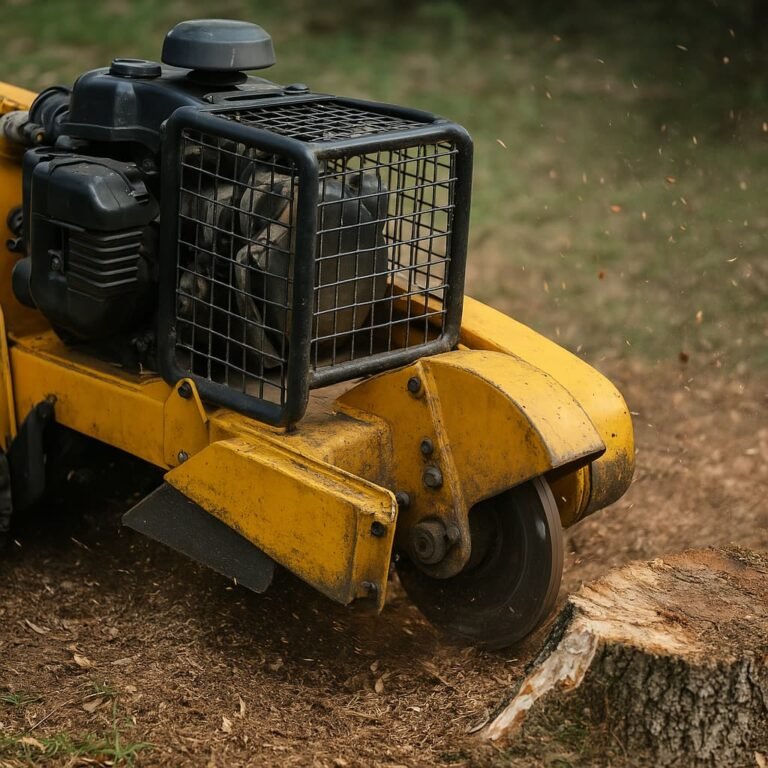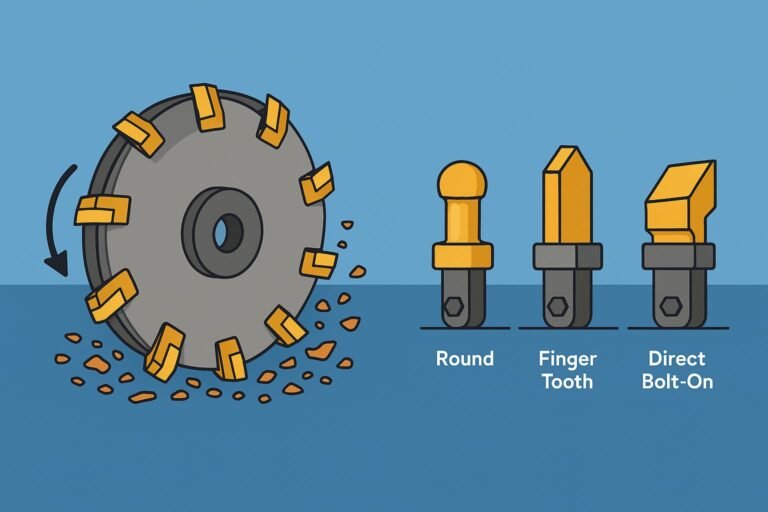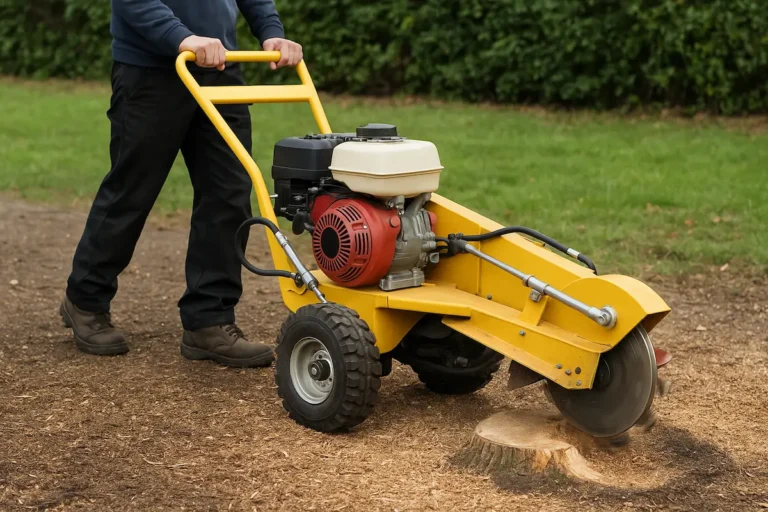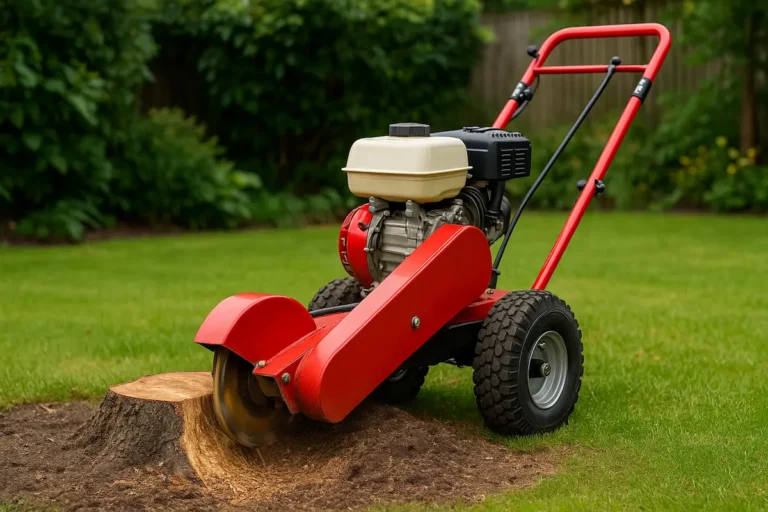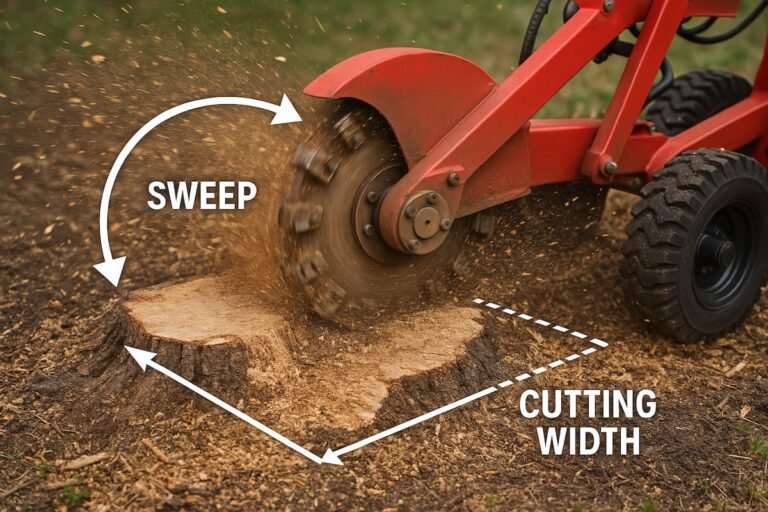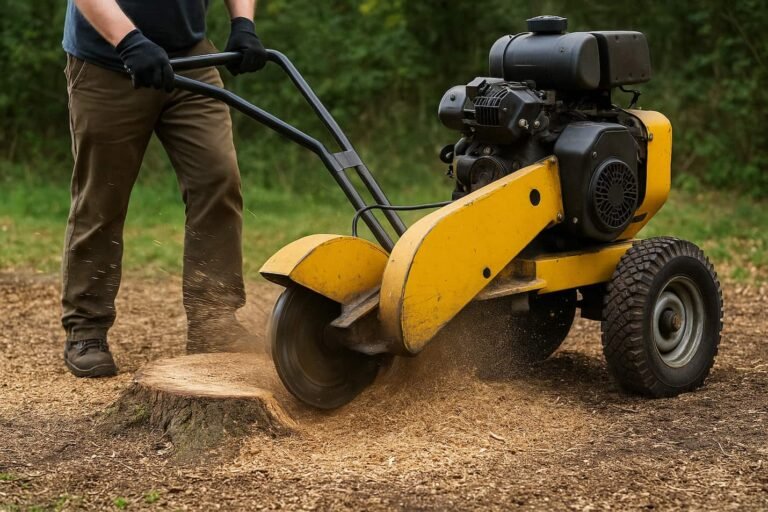The Ultimate UK Guide to Stump Grinder Carbide Teeth & Tips
Carbide teeth cut tree stumps fast.
They are super important for stump grinders.
Good teeth make the job much easier.
This guide explains everything about them.
Key Takeaways: Rotatable Stump Grinder Tooth Lifespan
- This chart illustrates the estimated operational lifespan range for rotatable carbide stump grinder teeth, based on typical user reports found in the guide.
- A single cutting edge on a rotatable tooth is estimated to last between 5 and 20 hours of active grinding time before needing rotation.
- By utilizing all available cutting edges through rotation, the total lifespan per tooth extends significantly, ranging from 15 to 60 hours.
- Crucial Note: These figures represent a wide range because actual tooth life is highly variable. Key factors include soil type (rocks, sand, debris drastically reduce life), operator skill (gentle vs. aggressive grinding), wood density, and the specific quality of the carbide tooth.
- Consistent maintenance (checking sharpness, timely rotation) is essential for maximizing the potential lifespan shown here.
Defining Carbide Teeth: What You Need to Know
Carbide teeth are the sharp bits on a stump grinder wheel.
They chew through wood and dirt.
Think of them like powerful teeth for the machine.
Most grinders will be created from tungsten carbide.
Unpacking the Material: Tungsten Carbide Explained
Tungsten carbide is super complicated stuff.
It mixes tiny tricky bits with a metal glue, usually cobalt.
This mix makes it incredibly tough.
It is much more complicated than standard steel.
On a hardness scale (Mohs), it scores about 8.5 to 9.
Steel scores much lower, 4 to 6.5.
This hardness lets teeth cut wood and handle dirt.
Understanding Their Function on the Grinder Wheel
These teeth attach to a big spinning wheel.
The wheel spins very, very fast.
The teeth hit the stump again and again.
They chip away the wood piece by piece.
They also grind through the soil around the stump.
This action turns the stump into small chips or mulch.
Key Properties: Hardness, Wear & Heat Resistance
Hardness is key.
It lets teeth cut tough wood easily.
It also helps them survive hitting soil and small stones.
Wear resistance means they last longer.
Because they are complex, they do not wear down quickly.
They resist rubbing against wood and gritty soil.
This gives them a longer cutting life than steel.
Heat resistance is also vital.
Grinding makes a lot of heat.
Carbide stays hard even when it gets hot.
Steel can get soft when hot, making it dull faster.
Carbide teeth keep cutting well, even under heat pressure.
Exploring Common Types of Stump Grinder Teeth
There are a few main kinds of grinder teeth.
Operators choose based on their grinder and needs.
Knowing the types helps pick the right one.
Traditional Bolt-On Carbide Teeth
These are an older style but are still used.
A small square or rectangle carbide tip is stuck (brazed) onto a steel holder.
The whole holder bolts onto the grinder wheel.
They cut well when sharp.
To replace or sharpen, you often unbolt the whole unit.
This can take some time.
Rotatable & Indexable Teeth: The Modern Standard?
These types are very popular now.
Brands like Greenteeth or Multi-Tip make them.
They have a carbide tip you can turn around.
The tip often looks round or has several flat sides.
It sits in a holder called a ‘pocket’ that stays on the wheel.
When one edge gets dull, you loosen the tooth and turn it.
This shows a new, sharp cutting edge.
It saves a lot of time compared to bolt-on teeth.
You use more of the carbide tip before needing a complete replacement.
Focus on Greenteeth: Why They Dominate Discussions
Greenteeth is a very well-known brand.
Many grinder users talk about them online.
Their LoPro™ series is mentioned often.
People like that you can rotate the tooth.
You get 2 or 3 fresh edges per tooth, depending on the type.
This means less downtime and more grinding.
Users report they cut quickly and efficiently.
Surveying Other Rotatable & Fixed Brands
Greenteeth is not the only option.
Other companies make good teeth, too.
Leonardi makes different tooth systems.
Sandvik, Yellow Jacket, and Rayco (Super Teeth) are other names you might hear.
Some offer rotatable designs, and others provide fixed bolt-on types.
Different brands suit different machines or budgets.
Understanding Finger Teeth Designs
Finger teeth look longer and thinner.
They resemble fingers sticking out from the wheel.
Certain grinder models use this specific type.
They might be chosen for particular grinding jobs.
Their shape affects how they cut into the stump.
Analysing Performance, Durability, and Lifespan
How long carbide teeth last is a big question.
Sadly, there is no single easy answer.
Many things change how long teeth survive.
Why Tooth Lifespan Varies So Greatly
- Soil is a huge factor. Grinding in clean soil is best. Rocky soil destroys teeth quickly. Sandy soil wears them down fast. Hidden rubbish like bricks or metal is awful. Hitting a rock can break a tooth instantly. This is the main reason teeth fail early.
- How you use the grinder matters. A skilled operator is gentle. They avoid plunging too deep and too fast. They try not to hit rocks directly. They use the right sweep speed across the stump. Careful use makes teeth last much longer.
- Grinder size and power play a part. Big, powerful grinders can stress teeth more, but they also grind stumps faster, changing the wear pattern on the teeth.
- Wood type affects wear. Hardwoods, like oak, wear teeth faster, while softer woods, like pine, are easier on them.
- Tooth quality makes a difference. Teeth from good brands often last longer. They use better quality carbide and binders. Cheap, unknown brands might wear out or break easily. You usually get what you pay for.
Estimating Teeth Longevity: What Users Report
It is hard to give exact numbers.
User reports online give us clues.
This is what people often say:
- One sharp edge on a rotatable tooth (like Greenteeth) might last 5 to 20 hours of actual grinding.
- Using all the edges (rotating the tooth fully) might give 15 to 60 hours total.
- Standard non-rotatable teeth lifespans vary just as much.
Remember: These are just rough ideas.
Someone grinding on very rocky ground might wreck teeth in minutes.
Someone in perfectly clean soil might get a much longer life.
One user said: “Hit one rock, and you can lose a couple [teeth] right away.”
Common Problems Summary Box
- Hitting Rocks/Debris: Breaks or chips teeth instantly. The biggest risk.
- Fast Wear in Bad Soil: Sandy or gritty soil acts like sandpaper, dulling teeth quickly.
- Dull Edges: Teeth become rounded, cutting slowly and poorly. Puts strain on the grinder.
- Broken/Cracked Teeth: This can happen from impact or sometimes poor quality. Needs immediate replacement.
- Loose Bolts: Teeth can wobble or even fly off if bolts are not tight. Very dangerous.
The Critical Impact of Tooth Sharpness
Using dull teeth is a bad idea.
Dull teeth cut very slowly.
They make the grinder work much harder.
This strains the engine and other parts.
Dull teeth create fine dust, not lovely chips.
The operator has to push harder, which is tiring.
Keeping teeth sharp saves time and money.
Sharp teeth cut faster and cleaner.
They put less stress on the machine.
The job gets done quicker with less effort.
Mastering Maintenance: Sharpening and Replacing Teeth
Looking after your carbide teeth is vital.
Good maintenance keeps them cutting well.
It also makes them last as long as possible.
Conducting Regular Inspections: Your First Line of Defence
Check your teeth often.
Look before you start grinding.
Recheck them after you finish.
Look for any chips or cracks.
See if any teeth are broken or missing.
Check if the cutting edges feel dull or rounded.
Make sure the bolts holding the teeth are tight. Loose bolts are dangerous.
Leveraging Rotation for Indexable Teeth
If you have rotatable teeth, use that feature!
When you notice cutting speed dropping, it is time to rotate.
Do not wait until the edge is completely ruined.
Rotating is usually quick and easy.
Loosen the locking screw, turn the tooth to a fresh edge, and tighten it again.
This is a significant benefit shown in many online videos.
One user noted: “Rotating a tooth takes minutes compared to swapping the old bolt-on ones.”
Sharpening Carbide Teeth Effectively
You can sharpen many carbide teeth.
This brings back a sharp cutting edge.
- How to Sharpen: You need special tools. A bench grinder is ordinary. Use a “green” silicon carbide wheel for carbide. Better still is a diamond grinding wheel. Diamond wheels cut carbide best without overheating it. Some people use handheld grinders with diamond discs for quick touch-ups.
- DIY vs. Professional: Many operators sharpen their own teeth, saving money on buying new ones or sending them away. But you need to learn the right way. Using the wrong angle or getting the tooth too hot can damage it. Overheating makes carbide brittle. Professional sharpening services have the right gear and ensure the correct angles are used.
- When to Sharpen: Sharpen when you feel the cutting getting slower. Sharpen before the edge gets badly rounded or chipped. Don’t wait too long.
A YouTube comment often seen: “Took some practice to get the angle right, but saves me a lot compared to sending them out.”
Knowing When and How to Replace Teeth
Sometimes, sharpening is not enough.
You need to replace teeth when:
- They are badly chipped or cracked.
- They are too worn down to get a good edge anymore.
- The steel holder part is damaged.
- A tooth is missing.
Always use the correct replacement tooth for your system.
Crucially, check the mounting bolts.
If bolts look worn, stretched, or damaged, replace them too.
Using old, weak bolts is risky.
Calculating the True Cost of Carbide Teeth
Carbide teeth cost money upfront and over time.
Understanding the costs helps you budget.
It also helps choose the best value teeth.
Understanding Initial Purchase Prices
The price tag varies a lot.
- Single rotatable tips (like Greenteeth) might cost around £8 to £20+ each. (Based on USD 10-25+)
- Standard bolt-on teeth prices differ based on size and maker.
- A complete set of teeth for a grinder can be expensive. It might cost £150 to £800+, or even more for big machines. (Based on USD 200-1000+)
Prices depend on the brand, the type of tooth, and how many you buy.
Evaluating Long-Term Operating Costs
The actual cost is not just the purchase price.
Think about:
- How long does each tooth (or edge) last?
- How many times can you rotate or sharpen it?
- How much does sharpening cost? (Your time and wheel cost if DIY, service fee if outsourced).
- How often do you need to replace them fully?
- How much time does maintenance take (downtime)?
Rotatable teeth might cost more to buy initially.
But they can be cheaper per hour of grinding.
This is because you get multiple edges per tooth.
And rotation is faster than changing bolt-on teeth.
Factoring in the High Cost of Unexpected Failure
Hitting something hard can ruin your budget.
Smashing several teeth on hidden concrete or metal gets expensive fast.
You lose the cost of the teeth.
You lose grinding time while you replace them.
This turns a good job into a costly one.
As one user warned: “That’s $60 gone in an instant, plus the time to replace them.”
Debating Cheap Alternatives vs. Quality Brands
It is tempting to buy very cheap teeth online.
But many experienced users say they don’t do it.
Testimonials strongly advise against cheap, unknown brands.
- “These cheap Amazon teeth I tried were terrible.”
- “One broke on the second stump…”
- “…the rest were dull after just one day.”
- “Went back to [Reputable Brand] – lesson learned.”
Cheap teeth often wear out extremely fast.
They might chip or break much more quickly.
You end up spending more in the long run.
You also suffer more frustration and downtime.
Investing in quality teeth usually pays off.
Hearing from the Field: Real User Testimonials
Learning from others’ experiences is helpful.
Here is what grinder operators say online:
Insights Gleaned from YouTube Reviews & Demos
- “Switching to the Greenteeth system saved me so much time.” (Common feedback on rotatable systems).
- “Cutting seems faster, too, especially with fresh edges.”
- “You MUST check the ground for rocks… I hit hidden concrete and shattered three new teeth.” (Frequent warning).
- “I sharpen my teeth with a diamond wheel… saves me a lot.” (DIY sharpening view).
- “Just don’t let them get too hot when sharpening.” (Important sharpening tip).
Learning from Online Forum Discussions (Arborist/Lawn Care Sites)
- “In my sandy [area] soil, teeth wear fast even without rocks. I get maybe 8-10 hours per edge.” (Shows how location matters).
- “Anyone else notices [Brand X] teeth seem more brittle than [Brand Y]?” (Users compare brands).
- “Always keep spare teeth and bolts in the truck. Nothing worse than being stuck.”” (Practical advice).
- “Debating getting a grinder… What teeth system do you recommend for durability?” (Common question).
Illustrating Concepts with Mini Case Studies
Seeing examples helps us understand the points.
Case Study 1: Switching to a Rotatable Tooth System
A small tree service used old bolt-on teeth.
Changing worn teeth took them 30-45 minutes.
They switched to a Greenteeth rotatable system.
Now, rotating several dull edges takes only 5-10 minutes.
They felt jobs got done faster with sharp edges always ready.
The higher initial cost paid off within one season.
Case Study 2: The Financial Impact of Poor Site Conditions
An operator took a job grinding oak stumps.
The ground looked like clean soil.
But hidden bricks and metal bits were buried.
They broke almost half the teeth on their grinder wheel.
Replacing the teeth cost hundreds of pounds.
The job lost money because of unexpected damage.
This shows how site hazards are a significant risk.
Case Study 3: Achieving Savings Through DIY Sharpening
A YouTuber showed how they built a sharpening jig.
They used a bench grinder with a diamond wheel.
They carefully sharpened their teeth regularly.
They tracked how long the teeth lasted.
They claimed sharpening properly made each tooth last much longer.
This saved them significant money on buying new teeth each year.
Conclusion: Key Takeaways for Grinder Operators & Hire Companies
Good carbide teeth are essential for stump grinding.
They directly affect how well and how fast you work.
Key Points to Remember:
- Tungsten carbide provides needed hardness and wear resistance.
- Rotatable teeth (like Greenteeth) offer convenience and lower running costs.
- Tooth life depends heavily on soil conditions, operator skill, and tooth quality.
- Regular checks, rotation (if applicable), and sharpening are crucial.
- Quality teeth usually outperform cheap alternatives over time.
Specific Advice for the Stump Grinder Hire Sector
If you hire stump grinders, understanding teeth is vital.
- Factor tooth wear into your hire prices. Calculate an average cost per hour.
- Schedule regular maintenance. Check and sharpen/rotate teeth between hires.
- Assess damage fairly. Know the difference between normal wear and tear versus abuse (e.g., multiple teeth broken from impact). Your terms should cover damage costs.
- Advise your customers. Before starting, hirers should check the work area for rocks, pipes, and metal. Explain the essential use of this to reduce damage risk.
- Provide machines with sharp teeth. This improves customer satisfaction and helps your grinder perform better and last longer.
Well-maintained teeth lead to happier customers and better profits.
Find the perfect machine for your job.
Check out our Tree Stump Grinder Hire listings today!

